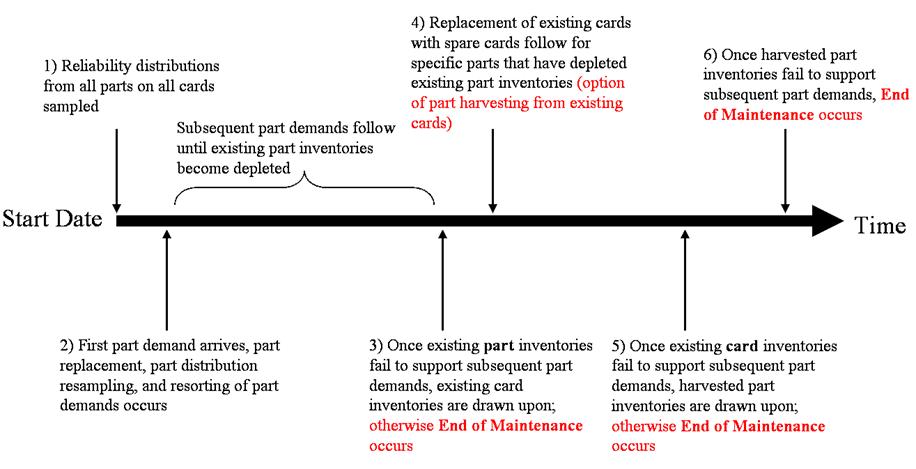|
Introduction to EOR/EOM
The tool is a stochastic discrete-event simulation that follows the life history of a population of parts and cards and determines how long the system can be sustained based upon existing inventories of replacement parts and cards, and harvesting of parts off of existing cards.† In discrete-event simulation, the operation of a system is represented as a chronological sequence of events. Each event occurs at an instant in time, and marks a change of state in the system.† The EOR/EOM simulator follows individual parts through their fielded lifetimes.† When a part fails, a maintenance event occurs (either to replace the part or the card that the failed part is located on).† The simulation ends when the maintenance events can no longer be performed based upon existing non-replenishable inventories of spare parts and cards.† In order to capture uncertainties in the characteristics of part failures and in the uncertainties in the characteristics of when the various maintenance events take place, the simulator follows a population of electronic systems through several life histories and determines probability distributions of system the resulting end of maintenance times.
End of Repair/End of Maintenance
The tool classifies the terms EOR and EOM as the following:
End of Repair (EOR): The date that the last repair or manufacturing action associated with a part can be successfully performed.
End of Maintenance (EOM): The earliest date that all available inventories fail to support the demand for one or more specific parts resulting in the loss of system operation.
Figure 1. Overview of the End of Repair/End of Maintenance Model
Publications A. Konoza and P. Sandborn, ďAn Evaluation of End of Maintenance Dates for Electronic Assemblies,Ē Proceedings of the Aircraft Airworthiness & Sustainment Conference, Baltimore, MD, April 2012.
Lifetime Buys Lifetime buys refer to buying enough parts
from the original manufacturer prior to the part's discontinuance in order to
support all forecasted future part needs throughout the system's required
support life. The Lifetime Buy (LTB)
model is a reverse-application of the EOR/EOM model, that follows the life
history of an electronic system and determines the number of spares required
to ensure system sustainment. The
LTB model can be used to generate optimum lifetime buy quantities of parts
that minimizes the total life-cycle cost associated with the estimated
lifetime buy quantity.
Download Model The End of Repair/End of Maintenance Model application and associated documentation can be downloaded from the following links. You will be queried for a CALCE login and password when downloading the materials below. If you do not have a login and password please contact sandborn@calce.umd.edu; at this time appropriate logins and passwords are available only for CALCE members. |
|
End of Repair/End of Maintenance (EOR/EOM) and Lifetime Buy Model |
|
The software on this web site was developed by the CALCE Electronic Products and Systems Consortium at the University of Maryland, College Park (Project Numbers: C11-11 and C12-26). The EOR/EOM tool is designed to estimate the end of repair and end of maintenance dates of systems.† The LTB tool is designed to estimate the cost associated with specific lifetime buy quantities and can be used to optimize the buy size. |

|
CALCE Electronic Systems Cost Modeling Laboratory, University of Maryland, College Park Home Page: http://www.enme.umd.edu/ESCMLLast Updated: September 17, 2012 |
|
Important Note:† The model has been developed and tested on Windows operating system, no attempt has been made to adapt the toolís functionality for performance on other platforms. |

|
Release Date |
Model Version |
Documentation |
Release Notes |
|
October 16th, 2011 |
|
New Features: ∑ Model Documentation ∑ Save/Load Features
|
|
|
September 14, 2012 |
∑ EOR/EOM and LTB Userís Guide
|
New Features: ∑ Lifetime Buy (LTB) Model ∑ Detailed Cost Modeling ∑ Design Refresh Planning
|